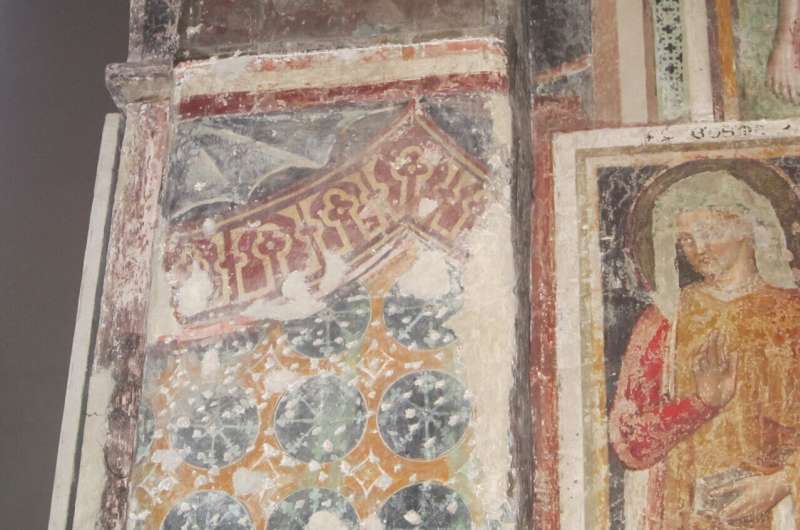A 13th-century fresco rediscovered in Ferrara, Italy, provides unique evidence of medieval churches using Islamic tents to conceal their high altars. The 700-year-old fresco is thought to be the only surviving image of its kind, offering precious evidence of a little-known Christian practice.
The partially-visible fresco, identified by Cambridge University historian Dr. Federica Gigante, almost certainly depicts a real tent, now lost, which the artist may have seen in the same church. The brightly colored original tent, covered in jewels, could have been a diplomatic gift from a Muslim leader or a trophy seized from the battlefield.
Gigante’s research, published today in The Burlington Magazine, also suggests that a high-profile figure such as Pope Innocent IV—who gifted several precious textiles to the Benedictine convent church of S. Antonio in Polesine, Ferrara, where the fresco was painted—may have given such a tent.
“At first, it seemed unbelievable and just too exciting that this could be an Islamic tent,” said Dr. Gigante. “I quickly dismissed the idea and only went back to it years later with more experience and a braver attitude to research. We probably won’t find another such surviving image. I haven’t stopped looking but my guess is that it is fairly unique.”
The fresco provides crucial evidence of a medieval church using Islamic tents in key Christian practices, including mass, the study suggests.
“Islamic textiles were associated with the Holy Land from where pilgrims and crusaders brought back the most precious such Islamic textiles,” Gigante said. “They thought there existed artistic continuity from the time of Christ so their use in a Christian context was more than justified. Christians in medieval Europe admired Islamic art without fully realizing it.”

While it is well known that Islamic textiles were present in late medieval European churches, surviving fragments are usually found wrapped around relics or in the burials of important people. Depictions of Islamic textiles survive, in traces, on some church walls in Italy as well as in Italian paintings of the late medieval period. But images of Islamic tents from the Western Islamic world, such as Spain, are extremely rare and this might be the only detailed, full-size depiction to be identified.
The fresco was painted between the late 13th and early 14th centuries to represent a canopy placed over the high altar. The artist transformed the apse into a tent comprising a blue and golden drapery wrapped around the three walls and topped by a double-tier bejeweled conical canopy of the type found throughout the Islamic world.
“The artist put a lot of effort into making the textile appear life-like,” Gigante said.
The background was a blue sky covered in stars and birds, giving the impression of a tent erected out in the open. In the early 15th century, the fresco was partly painted over with scenes from the lives of the Virgin Mary and Jesus Christ. This later fresco has captured the attention of art historians who have overlooked the sections of older fresco. Gigante identified the depiction of Islamic textiles when she visited the church ten years ago but it took further research to prove that the fresco represents an Islamic tent.
Depiction of a real tent used as altar-curtains
Gigante argues that the fresco depicts an Islamic tent which actually existed and that at some point in the 13th century, may even have been physically present in the convent church, providing a direct reference point for the artist.

It is already known that medieval churches used precious textile hangings to conceal the altar from view either permanently, during Mass or for specific liturgical periods. And when studying the fresco, Gigante noticed that it depicts the corner of a veil, painted as if drawn in front of the altar. Gigante, therefore, believes that the real tent was adapted to serve as a ‘tetravela’, altar-curtains.
“If the real tent was only erected in the church on certain occasions, the fresco could have served as a visual reminder of its splendor when it was not in place,” Gigante said. “The interplay between painted and actual textiles can be found throughout Europe and the Islamic world in the late medieval period.”
Gigante’s study notes that the walls of the apse are studded with nails and brackets, and that they could have served as structural supports for a hanging textile.
Gigante points to the fresco’s ‘extraordinarily precise details’ as further evidence that it depicts a real tent. The fabric shown in the fresco features blue eight-pointed star motifs inscribed in roundels, the center of which was originally picked out in gold leaf, exactly like the golden fabrics used for such precious Islamic tents. A band with pseudo-Arabic inscriptions runs along the edge of both the top and bottom border. The textile also features white contours to emphasize contrasting colors reflecting a trend in 13th-century Andalusi silk design.
The structure, design and color scheme of the tent closely resemble the few surviving depictions of Andalusi tents, including in the 13th-century manuscript, the Cantigas de Santa Maria. They also match one of the few potential surviving Andalusi tent fragments, the ‘Fermo chasuble’, which is said to have belonged to St Thomas Becket, Archbishop of Canterbury.
Gigante also compares the jewels depicted in the fresco with a rare surviving jeweled textile made by Arab craftsmen, the mantle of the Norman King Roger II of Sicily (1095–1154), which was embroidered with gold and applied with pearls, gemstones and cloisonné enamel.

Spoils of war
In the 13th century, it was common for banners and other spoils of war to be displayed around church altars in Europe.
“Tents, especially Islamic royal tents were among the most prized gifts in diplomatic exchanges, the most prominent royal insignia on campsites and the most sought-after spoils on battlefields,” Gigante said.
“Tents made their way into Europe as booty. During anti-Muslim expeditions, it was common to pay mercenaries in textiles and a tent was the ultimate prize. The fresco matches descriptions of royal Islamic tents which were seized during the wars of Christian expansion into al-Andalus in the 13th century.”
Gift from a Pope?
From the 9th century, Popes often donated Tetravela (altar-curtains) to churches and papal records reveal that by 1255, Pope Innocent IV had sent ‘draperies of the finest silk and gold fabrics’ to the convent of S. Antonio in Polesine.

“We can’t be certain but it is possible that a person of high-profile such as Pope Innocent IV gifted the tent,” Gigante says.
An Andalusi tent taken from the campsite of the Almohad caliph Muhammad al-Nāsir was sent to Pope Innocent III after 1212 meaning that there was an Islamic tent in St Peter’s Basilica at some point prior to the painting of the fresco.
Gigante suggests that the tent could also have been part of a diplomatic gift made to the powerful Este family which brokered alliances between the Guelfs and Ghibellins, factions supporting the Pope and the Holy Roman Emperor respectively. The convent was founded in 1249 by Beatrice II d’Este.
“Many people don’t realize how extraordinarily advanced and admired Islamic culture was in the medieval period,” Gigante said.
Last year, Dr. Gigante identified the Verona Astrolabe, an eleventh-century Islamic astrolabe bearing both Arabic and Hebrew inscriptions.
Federica Gigante is a Research Associate at the University of Cambridge’s Faculty of History and the Hanna Kiel Fellow at I Tatti, the Harvard University Center for Italian Renaissance Studies.
More information:
F. Gigante, ‘An Islamic tent in S. Antonio in Polesine, Ferrara’, The Burlington Magazine (2025)
Provided by
University of Cambridge
Citation:
Rediscovered fresco reveals Islamic tents in medieval Christian churches (2025, February 1)
retrieved 1 February 2025
from https://phys.org/news/2025-02-rediscovered-fresco-reveals-islamic-tents.html
This document is subject to copyright. Apart from any fair dealing for the purpose of private study or research, no
part may be reproduced without the written permission. The content is provided for information purposes only.

